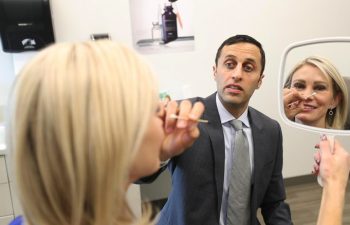
Deciding to get eyelid surgery is a complicated and highly involved decision. But one day, those droopy, sagging eyelids might be too much to handle so now you’re doing the research to answer the big questions. When is eyelid surgery medically necessary? How much does eyelid surgery cost? However, one of the most most asked questions concerning eyelid surgery is insurance-related.
But when does insurance cover eyelid surgery, and what are the requirements for eyelid surgery to be a covered medical procedure?
For some people, eyelid surgery can help vision and is referred to as Functional Eyelid Surgery. An upper eyelid lift is one type of procedure that could fall in this category. This includes a blepharoplasty, an eyelid ptosis repair or fixing a drooping brow. Most commonly associated with plastic surgery and aesthetic-type procedures, the procedure seeks to eliminate excess skin over the upper eyelids or to open the eyelids more. Having the eyelids more open can help some people see better, and more often than not, people are raising their eyebrows constantly to open their eyes, which is a sign of a droopy eyelid. When the eyelid surgery is simply to remove puffiness around the eyes, this is considered an elective procedure and not covered by insurance.
One can qualify for eyelid surgery, covered by medical insurance, if it is deemed medically necessary. The main reason cited is impaired vision is caused by excess upper eyelid skin which can make everyday activities such as driving, reading and using telecommunication devices much more hazardous. Let your doctor know if you are having specific issues in your daily life from your droopy eyelids. Functional eyelid surgery can include removing excess skin overhanging the eyelashes, opening the eyes by raising the level where the eyelashes sit if they are covering your pupil, or lifting a drooping brow for some insurance plans that allow this as a covered procedure..
To first see if eyelid surgery is covered by insurance, the first step is to look up your insurance carrier to see if it is even an option. When you visit the doctor, standardized photos will be taken and the doctor can determine if the eyelid is blocking your vision. A visual field test will be needed, as many insurance companies require proof in the form of a visual field test in order to determine coverage for eyelid surgery. The photos and visual field will be submitted to the patient’s insurance provider for approval. Your insurance company may decide you qualify for eyelid surgery through insurance for all or a portion of the eyelid surgery procedure cost, depending upon the patient’s specific insurance plan. Many plans do not cover any kind of brow surgery, and it is important to understand that there are restrictions that are out of the doctor’s control, and your surgery may be deemed out-of-pocket and not covered by your insurance. In addition, Medicare and other insurers will allow one type of procedure to be done but not two, so if you have a drooping eyelid and also excess skin, one of those procedures could very well be out-of-pocket.
Although excess eyelid skin (dermatochalasis) and droopy eyelids (ptosis) are common, there are other issues your doctor may need to rule out including:
- Hypertrophy of the orbicularis oculi
- Keratitis
- Blepharochalasis
- Eyebrow ptosis
- Lagophthalmos
- Malar festoons
- Protrusion of orbital fat
- Other causes of visual field defects
It is important to trust your eyes to a professional. Dr. Eftekhari is amongst the most highly trained surgical specialists for eyelid surgery called Oculoplastic Surgeons, with continued specialization completing 2 years of training through the American Society of Ophthalmic Plastic and Reconstructive Surgery (www.asoprs.org).
If you’d like to learn more about eyelid surgery, contact the Eyelid Center of Utah today for an appointment!
Posted on behalf of
